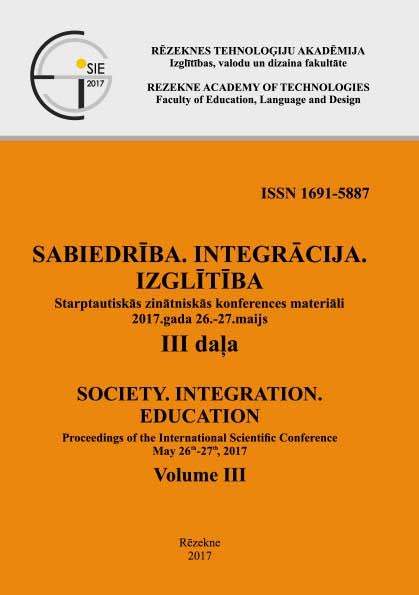THE CONTRIBUTION OF TECHNOLOGY TO AN UNDERGRADUATE INTERNATIONAL LEARNING PARTNERSHIP: THE RITUAL PERSPECTIVE
DOI:
https://doi.org/10.17770/sie2017vol3.2379Keywords:
Cultural Discourse Analysis, Ethnography of Communication, Ritual, Undergraduate TeachingAbstract
This study is part of a research project on a learning partnership between undergraduates of ViA, Latvia and UMM, USA. During the joint media course in Spring 2016, students participated in Skype discussions, completed shared assignments and reflected upon their learning experience. The transcripts of these activities form the body of qualitative data. We employ the perspective of Ethnography of Communication (Hymes 1962, Philipsen 1997) and Cultural Discourse Analysis (Carbaugh, 2007) in order to answer the following research questions: (1) what is the nature of the studied technology-mediated learning discourse, and (2) how do the constructed meanings around the use of technology contribute to the variety of cultural norms in play? We propose to understand the studied discussion sessions as a ritual practice (Turner 1980, Philipsen 1992, 1997)--the correct performance of which the participants instantly co-construct and negotiate when employing locally-adopted norms associated with democratic education practice--and assess the use and function of technology in the experienced learning interactions.Downloads
References
Alexander, B. K. (1999). Performing Culture in the Classroom: An Instructional (Auto)Ethnography. Text & Performance Quarterly, 19(4), 307
Braswell, G. g. (2015). Observations of Representational Practices by Indian-Descent Children in a US Preschool Classroom: Connections Among People, Spaces and Artifacts. Early Childhood Education Journal, 43(2), 135-142
Cameron, D. (2000). Good to talk? Living and working in a communication culture. Thousand Oaks, CA: Sage
Carbaugh, D. (2007). Cultural discourse analysis: Communication practices and intercultural encounters. Journal of Intercultural Communication Research, 36, 167-182
Carbaugh, D., Berry, M., & Nurmikari-Berry, M. (2006). Coding Personhood though Cultural Terms and Practices: Silence and Quietude as a Finnish “Natural Way of Being”. Journal of Language and Social Psychology. 25, 3, 2003-220
Carbaugh, D. (2005). Cultures in Conversation. NJ: Lawrence Erlbaum
Carbaugh, D. (1993). Cultural Pragmatics and Intercultural Competence. The Competent Intercultural Communicator: AFinLA Yearbook 1993, (eds. L. Lofman, L. Kurki-Suonio, S. Pellinen, & J. Lehtonen). Publications de 1'association finlandaise de linguistique applique, 51. 117-129
Cazden, C. B. (2001). The language of teaching and learning. The language of teaching and learning. Communication, 80(3), 348-369
Covarrubias, P. (2008). Masked Silence Sequences: Hearing Discrimination in College Classroom. Communication, Culture and Critique, 1 (3), 227-252
Damrow, A. (2014). Navigating the Structures of Elementary School in the United States and Japan: An Ethnography of the Particular. Anthropology & Education Quarterly, 45(1), 87-104.
Dedze, I., & Rubene, Z. (2016). Universities in Latvia - from the Soviet to European Higher Education Area. Foro de Educacion, 14(21), 13-38
Foucault, B., & Melican, J. (2007). The Digital and the Divine: Taking the Ritual View of Communication and ICT Interaction. HCI
Hall, B. (2005). How can we learn about our own and others’ cultures. Among cultures–The challenge of communication, 63-98.
Hymes, D. (1962). The ethnography of speaking. In T. Gladwin, W. C. Sturtevant (Eds.), Anthropology and Human Behavior (pp. 15-53). Washington, DC: Anthropological Society of Washington
Maybin, J. (2013). Towards a sociocultural understanding of children's voice. Language & Education: An International Journal, 27(5), 383-397 doi:10.1080/09500782.2012.704048
Obenchain, K. M., Balkute, A., Vaughn, E., & White, S. (2016). High School Teachers' Identities: Constructing Civic Selves. The High School Journal, 99(3), 252-278.
Philipsen, G. (1992). Speaking culturally: Explorations in Social Communication. Albany: State University of New York Press
Philipsen, G. (1997). A Theory of Speech Codes. In Philipsen G., Albrecht T. (Eds.) Developing Communication Theories (pp.119 – 156). Albany: State University of New York Press
Schildkraut, D. J. (2007). Defining American Identity in the Twenty‐First Century: How Much “There” is There? Journal of Politics, 69(3), 597-615
Spencer, M.B. (2011). American identity: Impact of youth’s differentia; experiences in society on their attachment to American ideals. Applied developmental science, 15, (2), 61-69
Turner, V. (1980). Social Dramas and Stories about Them. Critical Inquiry, Vol.7, No.1, 141-168
Waisbord, S. (2016). Communication Studies without Frontiers? Translation and Cosmopolitanism across Academic Cultures. International Journal of Communication, Vol 10, 868 - 886


